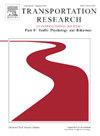Investigating driver responses to automated vehicles in a bottleneck scenario: The impact of lateral offset and eHMI
IF 3.5
2区 工程技术
Q1 PSYCHOLOGY, APPLIED
Transportation Research Part F-Traffic Psychology and Behaviour
Pub Date : 2025-06-23
DOI:10.1016/j.trf.2025.06.016
引用次数: 0
Abstract
This driving simulator study investigated drivers’ responses to an approaching automated or manual vehicle in a bottleneck scenario. Participants were asked to decide whether to pass through the bottleneck, or yield for the approaching vehicle, across numerous trials. Prior to each trial, they were informed whether the approaching vehicle was an automated vehicle (AV) or a manually driven vehicle (MV). Although participants were told that the MV was controlled by the experimenter using a distributed simulator, both vehicles were actually controlled by the system, and behaved in the same way. The kinematics of the approaching vehicle, such as its yielding behaviour (with or without lateral offset), and the presence of external Human Machine Interfaces (eHMIs, AV only) were manipulated. 40 participants took part in this study. Results indicated that participants’ subjective responses and behaviours did not differ between the AVs and MVs. The approaching vehicle’s lateral offset was seen to be the most influential source of information for participants, followed by information from the eHMI. Participants were more likely to pass through the bottleneck first, and had a shorter decision time, when encountering yielding vehicles with “away offsets”, which involved the vehicle moving away from the road centre line. This condition also led to higher perceived safety, comprehension, and trust ratings. Conversely, drivers were more likely to yield and had a shorter decision time when encountering non-yielding vehicles without any lateral offset. The lateral offset of non-yielding vehicles did not have an impact on drivers’ perceived safety and trust. However, non-yielding with “towards offsets” (towards the centre line) led to a higher comprehension score. Participants also passed through the bottleneck significantly more often and provided higher ratings for perceived safety and trust when the yielding vehicles presented an eHMI. This was regardless of lateral deviation. However, the eHMI only led to a higher rating of comprehension when the AV yielded without an offset. This study shows the value of using lateral offsets to communicate vehicles’ intentions in bottleneck scenarios. While the eHMI could enhance the driver’s understanding of the yielding AV, some participants also noted that it introduced uncertainty. Therefore, the need for eHMI should be further discussed.
在瓶颈情况下调查驾驶员对自动驾驶汽车的反应:横向偏移和eHMI的影响
这项驾驶模拟器研究调查了司机在瓶颈情况下对接近的自动或手动车辆的反应。参与者被要求在多次试验中决定是通过瓶颈,还是为驶来的车辆让路。在每次试验之前,他们被告知接近的车辆是自动驾驶车辆(AV)还是手动驾驶车辆(MV)。尽管参与者被告知MV是由使用分布式模拟器的实验者控制的,但实际上两辆车都是由系统控制的,并且表现方式相同。接近车辆的运动学,例如其屈服行为(有或没有横向偏移),以及外部人机接口(eHMIs,仅AV)的存在被操纵。40名参与者参加了这项研究。结果表明,被试的主观反应和行为在av组和mv组之间没有差异。接近车辆的横向偏移被认为是最具影响力的信息来源,其次是来自eHMI的信息。当遇到驶离道路中心线的“偏离偏移”车辆时,参与者更有可能首先通过瓶颈,并有更短的决策时间。这种情况也导致更高的感知安全,理解和信任评级。相反,当遇到没有横向偏移的不让步车辆时,司机更有可能让步,并且决策时间更短。非屈服车辆的横向偏移量对驾驶员的感知安全和信任没有影响。然而,不屈服的“向偏移”(向中线)导致更高的理解分数。当让步车辆呈现eHMI时,参与者也更频繁地通过瓶颈,并提供更高的感知安全和信任评级。这是不考虑横向偏差的。然而,eHMI只导致更高的评级理解当AV产生没有抵消。这项研究表明,在瓶颈情况下,使用横向偏移量来传达车辆意图的价值。虽然eHMI可以提高驾驶员对自动驾驶的理解,但一些与会者也指出,它带来了不确定性。因此,需要进一步讨论eHMI。
本文章由计算机程序翻译,如有差异,请以英文原文为准。
求助全文
约1分钟内获得全文
求助全文
来源期刊
CiteScore
7.60
自引率
14.60%
发文量
239
审稿时长
71 days
期刊介绍:
Transportation Research Part F: Traffic Psychology and Behaviour focuses on the behavioural and psychological aspects of traffic and transport. The aim of the journal is to enhance theory development, improve the quality of empirical studies and to stimulate the application of research findings in practice. TRF provides a focus and a means of communication for the considerable amount of research activities that are now being carried out in this field. The journal provides a forum for transportation researchers, psychologists, ergonomists, engineers and policy-makers with an interest in traffic and transport psychology.

 求助内容:
求助内容: 应助结果提醒方式:
应助结果提醒方式:


